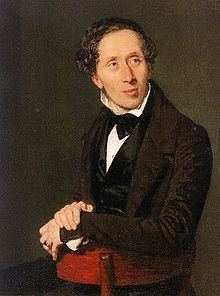Original title "Englen" Publication type Fairy tale collection Media type Print Country Denmark | Publisher C.A. Reitzel Originally published 11 November 1843 Genre Fairy tale | |
 | ||
Published in New Fairy Tales. First Volume. First Collection. 1844. (Nye Eventyr. Første Bind. Første Samling. 1844.) Similar Works by Hans Christian Andersen, Fairy tale books, Other books | ||
"The Angel" (Danish: Engelen) is a literary fairy tale by Hans Christian Andersen about an angel and a dead child gathering flowers to carry to Heaven. The tale was first published with three others in New Fairy Tales by C.A. Reitzel in November 1843. The four tales were received by the Danish critics with great acclaim. A print depicting the angel and child became very popular.
Contents
Plot
When the tale opens, a child has died, and an angel is escorting him to Heaven. They wander over the earth for a while, visiting well-known places. Along the way they gather flowers to transplant into the gardens of Heaven. The angel takes the child to a poverty-stricken area where a dead field lily lies in a trash heap. The angel salvages the flower explaining that it had cheered a crippled boy before he died. The angel then reveals he was the boy, and the boy continued his journey
Themes
Jens Andersen, author of Hans Christian Andersen: A New Life (2005) describes God as "one of Andersen's most beloved ghosts" and notes that God in "The Angel" is a "pleasant and helpful traveling companion [...] There are few figures in his works to whom he returns more often or examines from so many different childish angles." The poet had an unshakable faith that a whole new existence awaited him once his spirit left his earthly frame at the appropriate time. When Andersen was assailed with doubts regarding the soul's immortality, he reverted to his child faith and could not bring himself to suggest that the human being is simply dispersed as gases and other substances to fertilize the earth at death as the scientific Niels Bryde does in Andersen's 1857 novel, "To Be or Not To Be". Andersen regarded God as a release for those suffering and a new chance for those who have failed. God was an optimistic and promising beginning for Andersen.
Background
The tale is completely Andersen's invention, and may have been motivated by the death of the eldest daughter of his friends, Edvard and Jette Collins. The theme of a child transformed into an angel had possessed Andersen since the completion of his poem "The Dying Child". According to Gustav Hetsch, the story is one of three Anderson stories (along with "Beneath the Pillar and "The Nightingale") to have been inspired by Jenny Lind.
Publication history
"The Angel" was first published in Copenhagen on 11 November 1843 by C. A. Reitzel in the first volume of the first collection of New Fairy Tales. For the first time, the phrase "told for children" was not part of the title—an omission Andersen scholar and biographer Jackie Wullschlager believes exhibited a new confidence on Andersen's part: "These [tales] were the most mature and perfectly constructed tales he had written, and though some of them at once became, and have remained favorites of children, Andersen here melds together the childlike and the profound with exceptional artistry." The first edition of 850 was sold out by December 18, and Reitzel planned publication of another 850.
"The Angel" was the first tale in the volume that included "The Nightingale", "The Sweethearts; or, The Top and the Ball", and "The Ugly Duckling". The tale was republished 18 December 1849 in Fairy Tales and again on 15 December 1862 in Fairy Tales and Stories.
Wullschlager describes "The Angel" as a "sentimental genre picture [...] that suited the taste of the times." A print made from an illustration of the tale by the German artist Wilhelm von Kaulbach was widely popular and sold briskly. Andersen once found the print in Portugal, a country in which he was relatively unknown.
Critical response
New Fairy Tales was a break-through for Andersen who, until its publication, had generally received vigorous condemnation from the Danish critics for his venture into the fairy tale genre. Reviews for the collection however were ecstatic.
